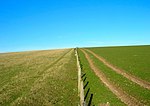Ouse Valley Railway
Rail transport in East SussexRail transport in West SussexRailways authorised but not built in the United KingdomUse British English from July 2015

The Ouse Valley Railway was to have been part of the London, Brighton & South Coast Railway (LBSCR). It was authorised by an Act of Parliament in 1864 and construction of the 20 miles (32 km) long line was begun, but not completed. It never opened to traffic.
Excerpt from the Wikipedia article Ouse Valley Railway (License: CC BY-SA 3.0, Authors, Images).Ouse Valley Railway
Haywards Heath Road, Mid Sussex
Geographical coordinates (GPS) Address Nearby Places Show on map
Geographical coordinates (GPS)
| Latitude | Longitude |
|---|---|
| N 51.033 ° | E -0.114 ° |
Address
Ouse Valley Viaduct
Haywards Heath Road
RH17 6QP Mid Sussex
England, United Kingdom
Open on Google Maps











